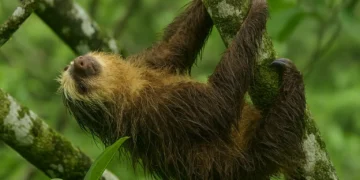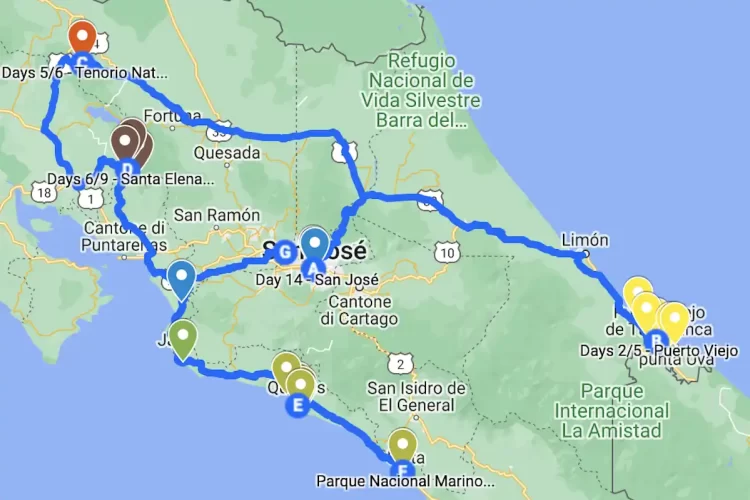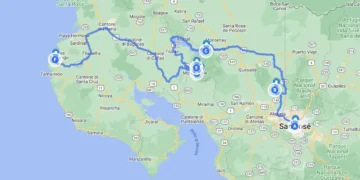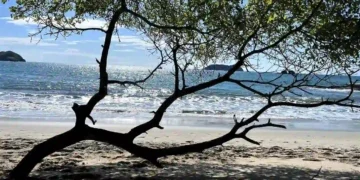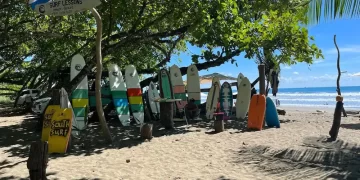Costa Rica in 14 days
Hi! In this article we want to offer you an itinerary to visit Costa Rica in 14 days. The Central American country, despite being relatively small, requires at least two weeks to appreciate all its qualities: fauna, beaches, attractions and cultural events. We therefore want to summarize our last trip that we took in January/February 2024, in order to give you updated information.
Thanks to this guide you will be able to get an idea of how to plan your trip to Costa Rica and, if you need it, you can estimate the expenses using our form created specifically for you, a traveler or passionate traveller.
Day 1: San José
he first day is usually dedicated to rest after the long plane journey. In fact, generally, planes to Costa Rica land at times that hardly allow you to do too demanding activities. We decided to leave San José as the last stop on our trip to Costa Rica, leaving immediately the next morning and planning a visit to the capital during the last few days.
So the advice we give you is to choose accommodation near the airport and leave the next morning. Obviously if you intend to stay in San José during the first few days you can take a look at the last steps of this itinerary.
We stayed in Matthias and Natalia’s B&B, two very hospitable and courteous guys. For 40 dollars we booked a double room with a private bathroom, however for breakfast we had to pay an additional 5 dollars. In any case, we will leave you the link if you need it.
Accommodation in San Jose: Guesthouse Casa Lapa 2
Checkout time: 11.00
Keep in mind that if you intend to stay in the capital for a long time you will be better off finding more central accommodation. Anyway, let’s get ready to leave for Puerto Viejo de Talamanca.
Days 2-5: Puerto Viejo de Talamanca, Cahuita National Park, Cocoa Museum

Due to jet lag we woke up at 5 in the morning, so we decided to hit the road without waiting for breakfast. Also because visiting Costa Rica in 14 days may seem easy, but in reality, especially for travel, it is not. With our Toyota Cross (which we thank) we easily took the highway towards Limón, even if despite the time of day we ran into some traffic. The journey from San José to Puerto Viejo de Talamanca takes approximately 3 hours and 30 minutes.
As soon as we left the metropolitan area of San José we began to experience the wonders of Costa Rica, as we suddenly found ourselves in the middle of the jungle. In fact, the road crosses the Braulio Carrillo National Park for about 20 km, offering a pinch of magic to the journey.
During the trip we forgot one small detail: hunger. Along the way it is not easy to find an area to stop, but at a certain point (like an oasis in the jungle) we spotted a small restaurant. Stopping we immediately noticed its peculiarity, in fact its hall looks directly into the woods full of sounds and tropical vegetation. The Restaurante Casa Manigua is therefore an obligatory stop: for a desajuno clasico (typical breakfast: rice, beans, fried plantains) the cost is 7 dollars.
After a feast of food and nature we set off again towards Limón. There is a lot of construction along the road at the time of writing, so the journey may take longer than expected. In any case, the stretch from Santa Clara to Limón was rather easy, even if without any particular attractions.
After passing the port city of Limón, we drove along Ruta Nacional Primaria 36 which runs along the Caribbean beaches. It goes without saying that the view here is anything but boring. Among palm trees and sun we continued for the remaining 50km, paying close attention to crossing wildlife.
For accommodation we opted for an apartment, so we stopped at a supermarket near Cahuita to do some shopping. Then we drove straight to Puerto Viejo. Between stops and roadworks our journey took longer than expected, so we arrived at our destination around lunchtime.
Our house was located a few meters from Playa Chiquita and we stayed in a little gem run by an Italian guy. We highly recommend this destination, as it is very close to all services and beaches: it also offers parking. Here is the link to view our accommodation.
Now let us advise you what to do these days:
- Playa Chiquita – The first thing we recommend is to visit the small Playa Chiquita which, as the name suggests, provides an intimate and particular glimpse of the Caribbean coast of Costa Rica. Here you will not find immense expanses of sand, but a small strip of land adorned with palm trees and mangroves. Here’s how to get there.
- Punta Uva – This beach is certainly larger than the nearby Playa Chiquita. Known above all for its surfing activities, Punta Uva is definitely a must-see to find some relaxation among plants and wild animals. Here we saw our first and only tapir. You can get there by following this location.
- Cahuita National Park – A visit to one of the most characteristic National Parks in Costa Rica cannot be missed. In addition to being largely populated by raccoons, this park allowed us to observe sloths and monkeys, as well as basilisks: the curious lizards that walk on the waterfall. We’ve written a comprehensive guide to Cahuita National Park, so we won’t go any further.
- Cocoa Museum – Cocoa is undoubtedly one of the strong points of Costa Rican culinary art. Inside the museum you can take a guided tour that will show you the entire chocolate making process. You will be the one to try your hand at roasting and grinding cocoa beans, we recommend that you take a leap by following these instructions.
- Puerto Viejo de Talamanca – The town of Puerto Viejo is very small. Its main street is just under a kilometer long and offers numerous small shops where you can make interesting purchases. Here you can also find practically all the services and find many places to enjoy local cocktails.
We decided to dedicate the remaining days to relaxation, but while you’re on your way you can pay a visit to the Guandoca Manzanillo National Park. In reality it is more correct to call it a refuge, as it protects a fantastic coral reef and many fauna species at risk of extinction. But now we’re off on a long journey, we’re heading towards the Tenorio Volcano National Park. Are we there?
Days 5-6: Tenorio National Park

We left Puerto Viejo de Talamanca very early to make the journey to Tenorio Volcano National Park. The volcano is located near Bijagua, so we decided to find accommodation for the night nearby. The journey from Puerto Viejo is in fact very tiring because it lasts about 6 hours, but obviously we recommend making intermediate stops: there are many panoramic points to stop at.
You could, for example, opt for a stop at the Braulio Carrillo National Park, which is practically located halfway. In any case, we continued on after a substantial breakfast, because we wanted to arrive before sunset and we knew that the last kilometers of the road were a little rough.
The area of the Tenorio Volcano is very rainy and for this reason the asphalt tends to flake off with a high frequency. We have to thank our beloved Toyota Corolla Cross, which allowed us to tackle the stretch from San Rafael to Bijagua with a certain amount of peace of mind.
We initially booked a cabinas close to the Rio Celeste: Cabinas Piuri. However, upon our arrival we found an unpleasant situation, with 99% humidity, cracked floors and drafty windows. In addition, the rain was pouring so, after trying to rest for a couple of hours, we decided to leave the accommodation due to the precarious conditions.
Not all evils have a silver lining, because within half an hour we found accommodation at the Finca La Amistad Cacao Lodge. We were demoralized and exhausted by the 6-hour journey, but we found a fantastic place: small wooden lodges were surrounded by cocoa trees and wild animals.

Yorleni, the owner, was very welcoming and made us find the accommodation very clean. In addition to preparing an excellent Costa Rican dinner based on rice, vegetables and chicken, she organized an unexpected night tour for us in a forest adjacent to the Finca. The tiredness was soon replaced by the enthusiasm of seeing something new and which we highly recommend.
The tour was reserved for us with a licensed guide, so we were on the safe side. Near our house there was a rainforest, not very large, belonging to a private owner who had initially used it for timber trees. After noticing that a real ecosystem had been established within the forest, the owner decided to leave everything as it was, favoring the formation of an enchanted place.
So when you get to the Cacao Lodges, ask Yorleni. She will know how to organize your stay. After a night’s rest, we headed to Tenorio Volcano National Park and had an unforgettable experience. We left very early (we recommend going to the parks at the first available time) and parked in a parking lot in front of the park at a cost of $8 (4000 colones).
As always at the entrance they checked that we had no food to introduce into the reserve, then we began our tour. We have drawn up a detailed guide on the Tenorio Volcano National Park, so we recommend that you read it to learn about every aspect of the protected area.
In this park you can admire the famous Rio Celeste and its waterfalls, as well as a rather rich fauna. During our visit we were lucky enough to encounter a family of coatis, numerous brightly colored butterflies and some snakes. The tour can be a bit tiring because the park is full of steep paths, so we recommend you bring enough water and go there without too much weight on you.
After leaving the Tenorio National Park we grabbed something to eat and immediately set off for Santa Elena. In fact, in the following days we had planned a visit to the Monteverde Biological Reserve and Selvatura Park for the suspension bridges. We decided to take an unusual route to reach Santa Elena, since we wanted to go along Lake Arenal.
Instead of taking the short route, we opted for the stretch of road that passes through Maguencal, Triunfo and Cabanga (Pueblo Nuevo). An undoubtedly tiring route (kilometres of bumpy road), which however gave us a truly evocative glimpse of rural Costa Rica. Among the hills and wind turbines, it was incredible to notice the number of schools, even though the road was little traveled, testifying to how much Costa Rica encourages education and safety for children and teenagers.
After a travel speed of around 30 km/h due to the road, we reached the asphalt stretch that runs along Lake Arenal, passing through the town of the same name. Here too the panorama gave us some breathtaking views, in fact we advise you to plan a stop in this area, even if we didn’t have time.

On the stretch of road that connects Arenal to Gudalajara, Piedras and Naranjo Agrios, you can find numerous restaurants and characteristic bars. In fact, we stopped to find some refreshment at a very characteristic soda: there are many, you won’t struggle to find them. Immediately afterwards we left the lake shore to travel the last hour of the journey.
If you want to rent a car for your trip, we recommend a small SUV, as the last stretch of road to Monteverde was also a bit uncomfortable. We arrived in Santa Elena in the late afternoon and found accommodation at Casa Clusias, opting for house 1. We recommend that you book the same house where we stayed, you will soon find out why.
Days 6-9: Monteverde and Selvatura Park

House 1 is part of a complex of 3 independent houses and is ideal for both couples and families. Upon our arrival in Santa Elena we needed comfortable accommodation and this suited our needs, thanks to a beautiful double bedroom with a small balcony overlooking the forest and a well-equipped kitchen. The bathroom is also very comfortable, with hot water always available and everything you need. The value for money was very advantageous, so we recommend it because we tried it in person.

After resting the first night, a nice tour awaited us at Selvatura Park, where we experienced the thrill of the suspension bridges and visited the sloth sanctuary. The weather wasn’t very kind as it rained for 2 days, however crossing the forest at 50 meters above sea level and among the clouds was something fantastic.
We recommend you take a look at this package which also includes the butterfly garden, as well as official guides and pick up from your accommodation (if you live in the Monteverde/Santa Elena area).
Selvatura Park has 8 suspension bridges of various heights and lengths, as well as numerous paths where you can admire local fauna and flora. However, as it is a rainforest, it will be very easy to encounter rain, so a windbreaker or a K-Way could come in handy. The difficulty is not high and once you have finished your route you could also consider doing the zip lines, that is, riding a pulley along a steel cable that connects two points in the forest.
The Sloth Sanctuary, on the other hand, was created to provide refreshment and hospitality to sloths who, injured or sick, could not survive in the wild. It’s not a very large place, but you can admire a dozen sloths walking around hanging upside down, very willing to take photos and videos. We recommend not using flash if you want to capture these moments, put yourself in the shoes of a sloth used to a slow and ordinary win.
Inside the park you can also find other attractions such as the reptile house and the nature walk, thanks to which you will be guided by an operator who will explain to you in detail the nature of each animal or tree. We skipped the reptile house because we don’t like seeing reptiles and amphibians in a display case, but that’s a matter of taste.
Returning from Selvatura Park we were pleased to discover one of the places where we ate best. The price was certainly not cheap (as in all tourist areas), but the particularity of the place still deserved it. At the Tree House you can eat practically everything and enjoy live music events, clearly here too the appreciation depends on personal taste. Not everyone loves this place because it’s noisy, but if you want to hear live music it’s the best place in all of Monteverde/Santa Elena.
The second day was dedicated to the Monteverde Biological Reserve, a very large protected area full of paths. It took us more than half a day to tour it all and here we had the privilege of seeing a Quetzal: a bird with plumage as beautiful as it is surreal. We have written an in-depth guide about the Monteverde Reserve, so we won’t go into too much detail. Just know that the reserve is actually a private protected area and that within it you can find paths with multiple degrees of difficulty.

However, we return to the accommodation. We said that it was a particular arrangement, this was because a young coati came to visit us on our balcony. In fact, house 1 seems to be a welcome destination for these mammals and, with all the necessary attention, we served meals when we could (obviously suitable for his diet). Do not feed wild animals unless you know their habits and main diet. Before setting off the next morning, the hairy quadruped accompanied our early morning wake-up call: then we headed towards Manuel Antonio.
Days 10-13: Manuel Antonio Park, beaches and whales

We kept Manuel Antonio National Park as the final destination of our tour, since to be honest we are not lovers of the cold and we knew we needed some nature and sea at 30°C, before returning to San José.
The journey from Santa Elena (Puntarenas Province) requires approximately 3 hours and 30 minutes of travel, but obviously it was unthinkable not to stop in the famous Playa Hermosa. The road was quite smooth, although we reluctantly noticed huge expanses of oil palms. Why reluctantly? You should know that in past years deforestation has been fierce and for business reasons growers have replaced the original forest with oil palms. However, the glance is fascinating, even if knowing what’s behind it ruins the whole poem. It’s not up to us to judge, so let’s proceed and make a stop at the seaside.
Playa Hermosa is a huge stretch of sand overlooking the Pacific Ocean. Unlike the Caribbean coasts, which are very narrow and short, this one is much more similar to the beaches you will have seen in numerous films. The beach is totally uncontaminated, so much so that there isn’t even a lifeguard tower. By the way, do you know the famous kiosk to open in Costa Rica? There aren’t very many of them, you should know. In any case we took a siesta for a couple of hours before setting off for Manuel Antonio again.

Our first destination was actually Quepos, but here too we experienced the negative side of remote bookings. Despite the excellent location of the house we had chosen, it overlooked the main road of Quepos that leads to the Manuel Antonio National Park. Well…since a bus passes every fifteen minutes you can imagine for yourself what happened. The host however was very kind and refunded us for the remaining days.
Here, for the second time during our trip, we had to find an alternative and instant solution. Nothing happens by chance, so we decided to go for a tour of the hotels in Manuel Antonio, right near the park. Here we met the “concierge” of an apartment near the park and, as if on purpose, we found ourselves in a house with a swimming pool and outdoor barbecue. We especially liked Casa Cielo for the morning visits of the toucans and macaws: we didn’t think they were that big. Obviously the swimming pool also played its part.
Our first day therefore ended in the swimming pool in the shade of palm and plane trees. The following day we had booked entry to the Manuel Antonio National Park for 7.00 am. We have also drawn up a detailed guide for this park which we invite you to read, which is why we can only tell you that Manuel Antonio was a unique experience. So unique that we decided to go there the following day too, to enjoy the sea, the iguanas to keep us company and, obviously, the beautiful paths of the park. We met a mother sloth with her baby, toucans, monkeys, iguanas, pelicans, turtles and anteaters. We couldn’t ask for more.
Our lunch spot at Manuel Antonio was Buru. A beachfront venue that provides live music events every day at 7pm, as well as very tasty cocktails. You can eat very well and at an overall affordable price, we recommend you go during happy hour from 4.30pm.

As mentioned, we reserved the second day again for the Manuel Antonio National Park, so we skip straight to the next day: the most beautiful experience of our lives. About an hour’s drive from Manuel Antonio is Marino Ballena National Park, known for whale and dolphin sightings. We waited for this day as if it were New Year’s Eve, with a hint of fear because whale sighting is not easy.
It is necessary to book one of the whale watching packages to be able to observe the whales. So we decided to rely on the Ballena Tour to go in search of these fantastic animals. As soon as we arrived the guide told us that we hadn’t seen any whales for days, so we were a little disheartened but at the same time optimistic.
We walked for a while before arriving at Uvita beach and getting on the boat. During the journey you will be able to enjoy fresh fruit, but we still recommend that you bring sunscreen and a hat. We have written a guide dedicated to whale watching, so we can only tell you that watching a mother whale look after her calf was a unique and unforgettable experience. You can’t help but enjoy our own experience, believe us!
Among other things, you may spot dolphins and sea turtles, as well as various pelicans and birds that live on the neighboring islands.

Upon returning from our tour to see the whales, we practically didn’t say a word, such was our amazement. We arrived in Manuel Antonio without realizing it and prepared for our departure the next day. The destination was San Josè, but we couldn’t fail to try to stop to see the turtles being released into the sea.
Along the way to San José we stopped at the Baby Sea Turtles Release, home of an association that works to protect sea turtles and ensure a safe haven for their eggs. Here you can release baby turtles into the sea with your own hands. Unfortunately when we arrived the eggs had not yet hatched and we were not able to try this experience, but with a voluntary donation you can have this possibility. We only advise you to ask for information well in advance, in fact the association will be able to tell you (more or less) when the eggs will hatch.
The journey to San Josè was longer than expected, since near Tarcoles we saw a crowd of curious people looking out from the parapet of the bridge overlooking the river of the same name. Since we were hungry we decided to stop and, with great amazement, we were lucky enough to spot a crocodile specimen of at least 5 or 6 metres. Together with him there were others similar to him, but also in this case we have prepared a dedicated guide if you want to know how to see crocodiles.
With a bit of melancholy in our hearts we left Tarcoles, we knew that our journey was about to end: however, the last destination in San José was missing.
Ultimo giorno: San José

We saved Costa Rica‘s capital for last, since our return flight was scheduled from Juan Santamaria Airport. So, before returning our beloved Toyota Corolla Cross, we dedicated an entire day to visiting the city. We list below what to see:
- Mercato centrale di San José
- Teatro Nacional
- Museo dell’oro
- Museo storico Jade
- Museo di arte costaricense
These are the main destinations to visit in San José, alternatively you can choose to take a guided tour of the city if you have little time available.
We have to tell you that we went to Costa Rica mainly for nature, so we did a very quick tour of the city. In the evening the return flight was waiting for us and during the journey we took the opportunity to retrace our trip, looking at photos and videos of our fantastic days in Costa Rica.
Is visiting Costa Rica in 14 days expensive?
This is a question that many ask us. Let’s say that visiting Costa Rica in 14 days is not one of the cheapest trips, especially if you consider other destinations such as Brazil or Bali, or even destinations in Africa. In Costa Rica, for example, there is a false myth regarding very cheap food: we read about complete lunches for 5 dollars on the web.
While this may be true in rural areas, this is not the case in tourist areas; if we consider that the intent of the trip is to visit “famous” destinations you can easily draw conclusions. However, there are many other costs that are decidedly lower than European standards, such as fuel and real estate: a 1000m2 plot of land near Playa Chiquita can cost 70,000 euros.
We recommend using our expense calculator that we have designed specifically for those who, like you, want to arrive prepared and without too many surprises in this fantastic country. Visiting Costa Rica in 14 days has affordable costs, but certainly it is not a low budget trip.
If you want advice, don’t hesitate to contact us, we try to respond to everyone as quickly as possible. We hope you enjoy our itinerary for visiting Costa Rica in 14 days. Pura Vida!

